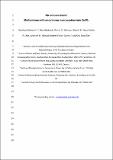Files in this item
No ion is an island : multiple ions influence boron incorporation into CaCO3
Item metadata
| dc.contributor.author | Henehan, Michael | |
| dc.contributor.author | Gebbinck, Christa D. Klein | |
| dc.contributor.author | Wyman, Jillian V.B. | |
| dc.contributor.author | Hain, Mathias P. | |
| dc.contributor.author | Rae, James W. B. | |
| dc.contributor.author | Honisch, Barbel | |
| dc.contributor.author | Foster, Gavin L. | |
| dc.contributor.author | Kim, Sang-Tae | |
| dc.date.accessioned | 2023-01-10T00:39:21Z | |
| dc.date.available | 2023-01-10T00:39:21Z | |
| dc.date.issued | 2022-02-01 | |
| dc.identifier | 277618504 | |
| dc.identifier | 77c919d5-dd8d-4d97-9916-57c31a9793d6 | |
| dc.identifier | 85122464941 | |
| dc.identifier | 000744097500005 | |
| dc.identifier.citation | Henehan , M , Gebbinck , C D K , Wyman , J V B , Hain , M P , Rae , J W B , Honisch , B , Foster , G L & Kim , S-T 2022 , ' No ion is an island : multiple ions influence boron incorporation into CaCO 3 ' , Geochimica et Cosmochimica Acta , vol. 318 , pp. 510-530 . https://doi.org/10.1016/j.gca.2021.12.011 | en |
| dc.identifier.issn | 0016-7037 | |
| dc.identifier.other | ORCID: /0000-0003-3904-2526/work/107287196 | |
| dc.identifier.uri | https://hdl.handle.net/10023/26728 | |
| dc.description | Funding: This research was supported by American Chemical Society – Petroleum Research Fund (ACS-PRF #50755-ND2), Natural Science and Engineering Research Council (NSERC) - Discovery Grants Program (386188-2010), Ontario Ministry of Research and Innovation - Ontario Research Fund (MRI-ORF #28001), Canada Foundation for Innovation - Leaders Opportunity Fund (CFI-LOF #28001) to S.-T. Kim. | en |
| dc.description.abstract | Boron isotope ratios – as measured in marine calcium carbonate – are an established tracer of past seawater and calcifying fluid pH, and thus a powerful tool for probing marine calcifier physiology and reconstructing past atmospheric CO2 levels. For such applications, understanding the inorganic baseline upon which foraminiferal vital effects or coral pH upregulation are superimposed should be an important prerequisite. Yet, investigations into boron isotope fractionation in synthetic CaCO3 polymorphs have often reported variable and even conflicting results, implying our understanding of the pathways of boron incorporation into calcium carbonate is incomplete. Here we address this topic with experimental data from synthetic calcite and aragonite precipitated across a range of pH in the presence of both Mg and Ca. We observe coherent patterns in B/Ca and Na/Ca ratios that, we suggest, point to paired substitution of Na and B into the carbonate lattice to achieve local charge balance. In addition, we confirm the results of previous studies that the boron isotope composition of inorganic aragonite precipitates closely reflects that of aqueous borate ion, but that inorganic calcites display a higher degree of scatter, and diverge from the boron isotope composition of aqueous borate ion at low pH. With reference to the simultaneous incorporation of other trace and minor elements, we put forward possible explanations for the observed variability in the concentration and isotopic composition of boron in synthetic CaCO3. In particular, we highlight the potential importance of interface electrostatics in driving variability in our own and published synthetic carbonate datasets. Importantly for palaeo-reconstruction, however, these electrostatic effects are unlikely to play as important a role during natural precipitation of biogenic carbonates. | |
| dc.format.extent | 21 | |
| dc.format.extent | 5375966 | |
| dc.language.iso | eng | |
| dc.relation.ispartof | Geochimica et Cosmochimica Acta | en |
| dc.subject | Boron Isotopes | en |
| dc.subject | Calcite | en |
| dc.subject | Aragonite | en |
| dc.subject | δ11B | en |
| dc.subject | pH proxy | en |
| dc.subject | Trace element incorporation | en |
| dc.subject | QD Chemistry | en |
| dc.subject | DAS | en |
| dc.subject | SDG 14 - Life Below Water | en |
| dc.subject | AC | en |
| dc.subject | MCC | en |
| dc.subject.lcc | QD | en |
| dc.title | No ion is an island : multiple ions influence boron incorporation into CaCO3 | en |
| dc.type | Journal article | en |
| dc.contributor.institution | University of St Andrews. Centre for Energy Ethics | en |
| dc.contributor.institution | University of St Andrews. School of Earth & Environmental Sciences | en |
| dc.contributor.institution | University of St Andrews. St Andrews Isotope Geochemistry | en |
| dc.identifier.doi | 10.1016/j.gca.2021.12.011 | |
| dc.description.status | Peer reviewed | en |
| dc.date.embargoedUntil | 2023-01-10 |
This item appears in the following Collection(s)
Items in the St Andrews Research Repository are protected by copyright, with all rights reserved, unless otherwise indicated.

